| |
Supplies for LX521 construction
and
system assembly
The LX521.4 loudspeaker system can be configured
from different components. In all cases the acoustic platform must be as
I designed it, as well as the crossover/equalizer transfer functions,
which determine the signal level and phase for each driver in the
acoustic baffle. Baffle shape and drivers define the all-important polar
response of the loudspeaker.

April 2017 - Here is an update to show where I am
with my two LX521.4 systems, which are set up in different
homes and rooms. I remind you that I design and build loudspeakers
for my own satisfaction and pleasure, striving for a maximum in realism
in a normal living space from a well done recording. The DSP System
below was my starter. The crossover/equalizer transfer functions where
derived from acoustic free-field measurements and implemented by a
miniDSP 4x10HD.
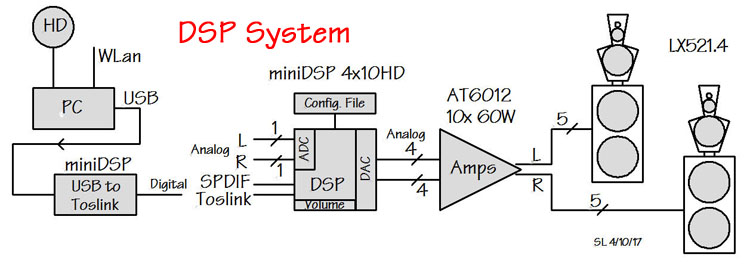
The ASP System below came about when I had exactly
duplicated the miniDSP 4x10HD derived transfer functions in analog
circuitry using operational amplifiers, resistors and capacitors. It
started as an engineering exercise to eliminate the digital signal
processor and have a loudspeaker, which operates from L and R electrical
input to acoustic output in the analog signal domain with which I am
most familiar. Of course the input signal itself has most likely gone
through digital processes these days. But at least there is a clear
dividing line.

Performance wise my reference has been the
PB6 System below. The ASP.4 and PB6 systems match to a degree where it
is difficult for me (I am not the youngest person anymore) to hear a
difference or to say which I prefer. But when I play files from a hard
disk HD directly into the front panel USB port of the Sonica DAC, then I
am able to hear differences between a 96kHz/24bit file and a DSD file of
the same recording. When I play the same files from the HD of the PC,
then JRiver converts the DSD file to 96kHz/24bit and I hear no
difference. The ASP System has thus become my highest resolution system.

To come to this point in my system developments
took three specific components:
- ASP.4 analog signal processor for crossover and
driver equalization functions
- AT528NC power amplifiers for complete sound
neutrality and bass control
- afi+USB isolator and reclocker for phantom
image stability and sound delineation
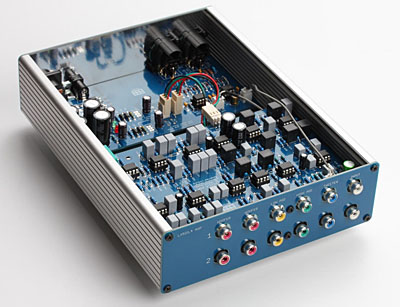 |
Mako Natsume
Hello Siegfried,
My plan is to offer
five PCBs as the standard configuration. Two boards are the ASP.4s,
another is a power supply that can be configured to accept an
external Mean Well +/-15 GP50A14E-R1B
a wall wart like the ADU160100Z5401
offered by Jameco (US, Canada) purely for convenience and
clearly not optimal, or an externally housed center tapped
transformer like the Hammond 1182J15 that can also connect through
the DIN plug (legends on the panel will be changed from below). The
power board also has an option for balanced inputs. The other two
boards are panels that will fit the Hammond case I sent to you but
with neatly countersunk holes. It is intended to double as a
template that users can create their own panel with. |
The ASP.4 circuit diagram has been shown on the LX521.4 owner
support page since 12/2016. See
the LX521.4 Store.
Support questions of OPLUG forum
registered LX521 documentation owners can be posted at the dedicated LX521
ASP Reworked thread.
New 2021: ASP
LX521.4 v2.0 with Cascaded Topology:
Phase issues in purely parallel crossover
topologies, typical in previous ASP LX521.4 versions, prevent proper summing to a flat frequency response.
Find more details on the topic in Siegfried Linkwitz'
"Crossover
topology issues"
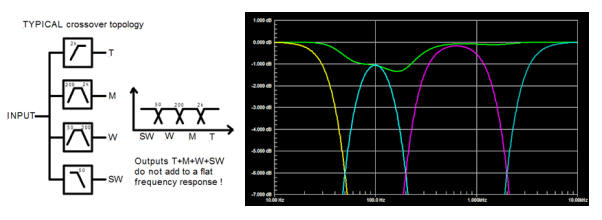
Siegfried Linkwitz' statement "An optimum
crossover filter topology should be the starting point when the outputs
from multiple drivers with different frequency responses and
sensitivities need to be combined for a flat acoustic response " was
the basis for the new edition of the
cascaded,
precision ASP LX521.4 v2.0.:



More about improved design details of LX521.4 v2.0
can be found
here.


Before shipping, the add-on circuit for alternative Lower Midrange
driver
LINKWITZ22MG can be activated upon request. Input and output plugs are XLR.
RCA-to-XLR
adaptors available.
The AT528NC Class D, 8x 200W, power amplifiers are essential to my ASP
System's perfection. They have extremely low distortion even at low output
power levels where much of the music detail is happening. Yet the
amplifiers also have enormous output current capability to keep the
woofers under full control.
 
Finally there is the USB isolator and
reclocker. I am still surprised that it is needed in my systems. My
primary source for sound is a notebook PC's USB port. The PC travels with
me between the two LX521.4 systems in different locations. I thought a
Sonica DAC would not benefit, but it does. The DAC performs flawlessly for
files from a thumb drive plugged into its front panel USB port. It
processes DSD files directly and without converting them to 96 kHz PCM
files as does JRiver in my PC. I was surprised to hear differences between
DSD and 96k/24bit versions of the same recording.
 |
This device points to
problems with the digital data and spurious signal streams coming
from the USB port of my PC. I will investigate this. The engineer
in me wants an answer. The writing in German or in English on the
afi website is not very clear about the internal workings of the
machine. And I do not know enough about digital bus traffic. I cut
open a USB printer cable and found loosely twisted data lines and
shielding that is only connected to the metal connector shell at
the source end (as specified!). That makes the "shield"
a nice antenna for EMI injection! The data lines are probably
poorly terminated, which will cause reflections and thus jitter.
But in the meantime I am happy that the
afi+USB does such a great job. |
*********************************************************************************
 |
The LX-Store
informs you about the components that are available for building
or buying an LX521.4 System.
The
LX521
Construction Plans are your license and access to
up-to-date Owner-Support information and the closed pages of the OPLUG
owner support forum.
More information is found in the older part
of Supplies for LX521 construction and
system assembly below: |
|
*********************************************************************************
Supplies for LX521 construction
and
system assembly
What do you need?
- Construction Plans
- 2 x Top baffle for midrange and tweeter
- 2 x V-frame for woofer
- 2 x Woofer bridge
- 2 x 6 Drivers (2 tweeters, 1 upper mid, 1 lower mid, 2
woofers)
- 2 x Passive crossover (4 mH inductor, 12 mF capacitor)
- Wire connections to the baffle mounted drivers,
crossover and terminal connectors
Analog Signal Processor and separate preamplifier with
remote volume control, or:
Digital Signal Processor with built-in IR remote volume
control capability- 6 x 180 W ATI power amplifier, or 12 x 60 W ATI power
amplifier, or equivalent
- Speaker cables and shielded interconnect cables
Details for above items, what to build yourself or where
to buy parts and assemblies, are given below.
I sell Construction Plans and blank printed circuit boards for the ASP. I
can order and have ATI power amplifiers shipped to you from the factory at a
special price. An order form is at the bottom of this page. Everything else can
be supplied by others, if you own Construction
Plans. For cables and interconnects see FAQ8.
The LX521 was designed for easy DIY construction and
without sacrifice to acoustic performance. It is important not to change the
baffle contours, the frequency response of the ASP, or the passive crossover. If
you want to experiment or have ideas about improving my design, then I recommend that you first build and listen to the LX521 having
followed the instructions in the Construction Plans. Support of the LX521
loudspeakers is provided via a web page to which owners of the LX521
Construction Plans have access. Additional construction and test information,
revisions and updates are posted on that page. Check it out before you start
building.
When building the speaker cabinets yourself, you will need to have some woodworking
capability. At minimum a circular saw and a saber
saw are required, but not a router. Alternatively, NC machined wood panels and
partially assembled cabinets are available from different suppliers. For the crossover you must load and
solder components onto a printed circuit board, and
connect wires where indicated. The finished assembly must to be tested
electrically to avoid using the costly drivers as fault indicators. A digital voltmeter,
a 20 Hz to 20 kHz sinewave signal source and AA-cell batteries are sufficient for spot checks.
Acoustic
measurements are not necessary, because of the consistency in production of the
SEAS drivers used.
The 34 pages of the LX521 Construction Plans contain:
- Drawings for all baffle parts
- Mechanical assembly instructions
- Driver and crossover wiring instructions
- ASP crossover/equalizer circuit description and diagram
- Material list for electrical components
- Loading chart for printed circuit boards
- Electrical assembly instructions
- Electrical test instructions
- System turn-on and test
- URL of the LX521 Owner Support Page
The LX521 Construction Plans are the
license to build the loudspeakers for personal use. They are also required when
subassemblies are purchased from other suppliers.
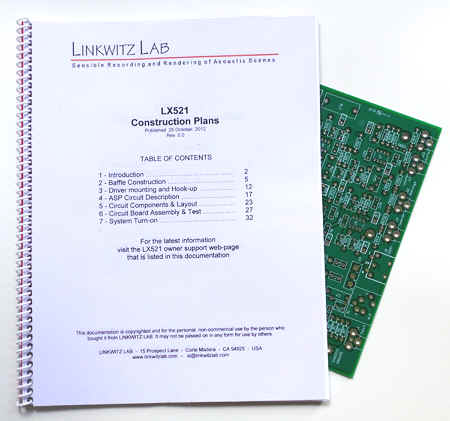 |
Estimated cost of materials
(prices of 2013)
Construction Plans
.................................................... $155
4 Tweeters, 4 Midranges, 4 Woofers .................... $1600
Wiring, connectors, passive xo, speaker cables .. $200
Wood, screws, glue, paint .......................................
$200
miniDSP 4x10HD ....................................................
$520
----------------------------------------------------
Subtotal $2675
6x180W Power amplifier ........................................ $1850
----------------------------------------------------------
Total $4525
|
Blank Printed Circuit Boards for the ASP
- check with
<www.LINKWITZ.store>
Printed circuit boards are essential for assembling the
Analog Signal Processor electronics. The ASP divides the incoming left and right
channel audio signals into woofer, midrange and tweeter channels for driving the
power amplifiers of left and right loudspeakers.
The LX521 ASP is assembled on the most recent ORION ASP printed circuit board.
It supports balanced and unbalanced inputs. Tweeter, midrange and two woofer
output connectors are unbalanced. Outputs can be attenuated to match power
amplifier voltage gains if they are not identical. Silk screened component
outlines and numbers on the pcb simplify loading the board. The board material
is FR4 with two layers of 1 oz copper, has plated through holes, top and bottom
solder mask and top silk screen. It is 0.062" thick and measures 7.6"
x 7". This industrial strength circuit board makes for easy soldering of
components. A praxis session is strongly recommended in order to learn
temperature and timing to get to wet and shiny looking solder joints. Cold
solder joints, solder bridges or burnt pads and damaged components can turn into
a nightmare when trouble-shooting a dysfunctional circuit. Two boards are
required for the ASP. (These boards may serve either for your DIY
ORION ASP or "vintage LX521.3-ASP" project)
 LX521 ASP proto LX521 ASP proto
Assembled
DSP and LX521 Configuration File
Instead of the
discontinued ASP a
Digital Signal Processor can be used to generate the appropriate woofer,
midrange and tweeter drive signals for the power amplifiers, which are
connected to the speakers.
A Configuration File is provided with the LX521 Construction Plans,
which needs to be loaded via USB from a computer into the DSP unit. The
miniDSP 4x10 Hd is ready made with both analog and digital inputs and
has volume control. The unit can be trained to recognize Sony/Philips IR
remote controls. It thus also replaces the preamplifier, which is
required in front of the ASP above. But the DSP lacks an indication of
volume level.
|

You need to purchase:
1 x miniDSP 4x10 Hd
1 x 4x10
plug-in firmware to structure the DSP for XO/EQ applications
|

Rear of miniDSP 4x10 Hd
See DSP challenge
for alternatives
|
|
For many years I have been using ATI power amplifiers. In
their product line the 12-channel AT6012 power amplifier is well suited to the
LX521. Each driver would have its own 60 W stereo amplifier, which can
provide as much peak current or peak voltage as I would ever want in my 100 m3
listening room at The Sea Ranch.
The AT6012 is rated at 60 W per
channel into 8
ohm FTC full bandwidth output power, with all 12 channels driven simultaneously.
The power supply has high current reserve and a 2000 VA transformer. A pair of
LX521 speakers utilizes 8 amplifiers, the LX521.4 would take 10 amplifiers. A separate amplifier channel is allocated
to each of the 10" dipole woofer drivers to obtain output capability that is
commensurate with the midrange, yet minimizes bottoming and the risk of
mechanical damage to the woofers, or having to reduce the speaker's low
frequency extension. At very high sound levels the amplifiers clip first, which
gives a clearly audible warning to turn down the volume.
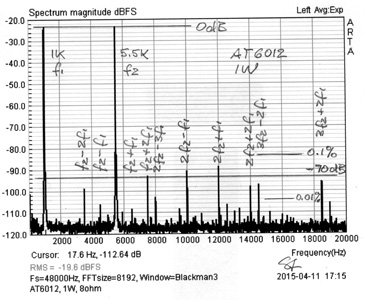 |
 |
The AT6012 exhibits good low power intermodulation
distortion performance as seen in the graphs above. It is primarily 3rd order at
1 W in response to equal amplitude input signals at 1 kHz and 5.5 kHz driving an
8 ohm resistor. Harmonic distortion products are always of lower amplitude than
intermodulation products. Unlike for many Class A/B amplifiers the distortion
does not increase as power goes down. A 100 mW output level is not unrealistic.
Early transistor radios had 50 mW output stages and made quite a bit of noise.
The AT1806
is a six-channel power amplifier rated at 180 W per channel. It can drive the
3-way LX521, if the two 10" drivers in each woofer baffle are connected in
parallel to one amplifier. The parallel drivers
present a low 2 ohm impedance to the power amplifier around 100 Hz. The power
amplifier driving this load must be capable of at least 200 W into 4 ohm.
The AT1806 is capable of
producing higher bass output volume from the LX521 than the AT6012 and handle
extreme loudness peaks. The DSP crossover/equalizer requires no
modification for its use.
But, the higher power
has the potential to bottom out and damage the woofers below 40 Hz and to overheat
or stress LXmini woofer/ midrange and
tweeter with high level test or transient signals. I never had a failure with
program material even at extreme volume levels.
The intermodulation distortion performance of the AT1806
at low power levels is exemplary.
The AT1202 is a two-channel power amplifier rated at 120 W per
channel. It would be needed to drive left and right LX521 tweeters, if the AT1806 powers
each dipole
woofer driver individually and also the LX521 lower mid upper midrange drivers
with their passive crossover. The AT1202 is a little safer for the LX521 tweeter
than the AT1806. In any case caution is advised with such high power amplifier
setup. A second AT1202 would be needed for the 10-channel LX521.4 to drive
the upper midrange drivers.
The intermodulation distortion performance of the AT1202
at low power levels is very good.
Note that my power description is for peak voltage
equivalent power. A 2 Vpeak sinewave at 1 kHz and a 2 Vpeak sinewave at 5.5 kHz
superimpose and fluctuate at a 4.5 kHz rate as seen on an oscilloscope. The
fluctuation has 4 Vpeak amplitude, which I call equivalent to "1 W"
for the conventional single frequency sinusoid of 4 Vpeak or 2.83 Vrms across 8
ohm. Similarly the "100 mW" description is for 1.26 Vpeak of the
superimposed sinusoids. The actual dissipated powers are 500 mW and 50 mW into 8
ohm.
Harmonic distortion products are below 0.01% for the three amplifiers measured.
But musical signals are rarely single sinusoids. Intermodulation distortions are
always higher than harmonic distortions and their spectral distribution is in my
opinion a better differentiator between amplifiers than a single harmonic
distortion number.
ATI making an amplifier -- ATI sales story
|
Power
amplifier related links:
|
Buyers of cabinet kits, pcb or assembled pcb's must own LX521
Construction Plans ($155).
See below for ordering, shipment cost and payment.
|